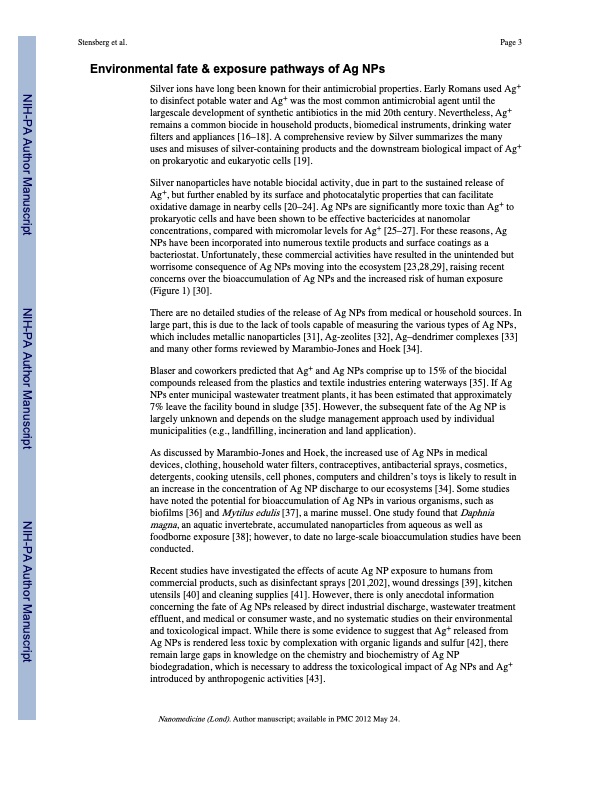
PDF Publication Title:
Text from PDF Page: 003
Stensberg et al. Page 3 Environmental fate & exposure pathways of Ag NPs Silver ions have long been known for their antimicrobial properties. Early Romans used Ag+ to disinfect potable water and Ag+ was the most common antimicrobial agent until the largescale development of synthetic antibiotics in the mid 20th century. Nevertheless, Ag+ remains a common biocide in household products, biomedical instruments, drinking water filters and appliances [16–18]. A comprehensive review by Silver summarizes the many uses and misuses of silver-containing products and the downstream biological impact of Ag+ on prokaryotic and eukaryotic cells [19]. Silver nanoparticles have notable biocidal activity, due in part to the sustained release of Ag+, but further enabled by its surface and photocatalytic properties that can facilitate oxidative damage in nearby cells [20–24]. Ag NPs are significantly more toxic than Ag+ to prokaryotic cells and have been shown to be effective bactericides at nanomolar concentrations, compared with micromolar levels for Ag+ [25–27]. For these reasons, Ag NPs have been incorporated into numerous textile products and surface coatings as a bacteriostat. Unfortunately, these commercial activities have resulted in the unintended but worrisome consequence of Ag NPs moving into the ecosystem [23,28,29], raising recent concerns over the bioaccumulation of Ag NPs and the increased risk of human exposure (Figure 1) [30]. There are no detailed studies of the release of Ag NPs from medical or household sources. In large part, this is due to the lack of tools capable of measuring the various types of Ag NPs, which includes metallic nanoparticles [31], Ag-zeolites [32], Ag–dendrimer complexes [33] and many other forms reviewed by Marambio-Jones and Hoek [34]. Blaser and coworkers predicted that Ag+ and Ag NPs comprise up to 15% of the biocidal compounds released from the plastics and textile industries entering waterways [35]. If Ag NPs enter municipal wastewater treatment plants, it has been estimated that approximately 7% leave the facility bound in sludge [35]. However, the subsequent fate of the Ag NP is largely unknown and depends on the sludge management approach used by individual municipalities (e.g., landfilling, incineration and land application). As discussed by Marambio-Jones and Hoek, the increased use of Ag NPs in medical devices, clothing, household water filters, contraceptives, antibacterial sprays, cosmetics, detergents, cooking utensils, cell phones, computers and children’s toys is likely to result in an increase in the concentration of Ag NP discharge to our ecosystems [34]. Some studies have noted the potential for bioaccumulation of Ag NPs in various organisms, such as biofilms [36] and Mytilus edulis [37], a marine mussel. One study found that Daphnia magna, an aquatic invertebrate, accumulated nanoparticles from aqueous as well as foodborne exposure [38]; however, to date no large-scale bioaccumulation studies have been conducted. Recent studies have investigated the effects of acute Ag NP exposure to humans from commercial products, such as disinfectant sprays [201,202], wound dressings [39], kitchen utensils [40] and cleaning supplies [41]. However, there is only anecdotal information concerning the fate of Ag NPs released by direct industrial discharge, wastewater treatment effluent, and medical or consumer waste, and no systematic studies on their environmental and toxicological impact. While there is some evidence to suggest that Ag+ released from Ag NPs is rendered less toxic by complexation with organic ligands and sulfur [42], there remain large gaps in knowledge on the chemistry and biochemistry of Ag NP biodegradation, which is necessary to address the toxicological impact of Ag NPs and Ag+ introduced by anthropogenic activities [43]. Nanomedicine (Lond). Author manuscript; available in PMC 2012 May 24. NIH-PA Author Manuscript NIH-PA Author Manuscript NIH-PA Author ManuscriptPDF Image | Toxicological studies on silver nanoparticles

PDF Search Title:
Toxicological studies on silver nanoparticlesOriginal File Name Searched:
nihms-316964.pdfDIY PDF Search: Google It | Yahoo | Bing
Turbine and System Plans CAD CAM: Special for this month, any plans are $10,000 for complete Cad/Cam blueprints. License is for one build. Try before you buy a production license. More Info
Waste Heat Power Technology: Organic Rankine Cycle uses waste heat to make electricity, shaft horsepower and cooling. More Info
All Turbine and System Products: Infinity Turbine ORD systems, turbine generator sets, build plans and more to use your waste heat from 30C to 100C. More Info
CO2 Phase Change Demonstrator: CO2 goes supercritical at 30 C. This is a experimental platform which you can use to demonstrate phase change with low heat. Includes integration area for small CO2 turbine, static generator, and more. This can also be used for a GTL Gas to Liquids experimental platform. More Info
Introducing the Infinity Turbine Products Infinity Turbine develops and builds systems for making power from waste heat. It also is working on innovative strategies for storing, making, and deploying energy. More Info
Need Strategy? Use our Consulting and analyst services Infinity Turbine LLC is pleased to announce its consulting and analyst services. We have worked in the renewable energy industry as a researcher, developing sales and markets, along with may inventions and innovations. More Info
Made in USA with Global Energy Millennial Web Engine These pages were made with the Global Energy Web PDF Engine using Filemaker (Claris) software.
Infinity Turbine Developing Spinning Disc Reactor SDR or Spinning Disc Reactors reduce processing time for liquid production of Silver Nanoparticles.
| CONTACT TEL: 608-238-6001 Email: greg@infinityturbine.com | RSS | AMP |